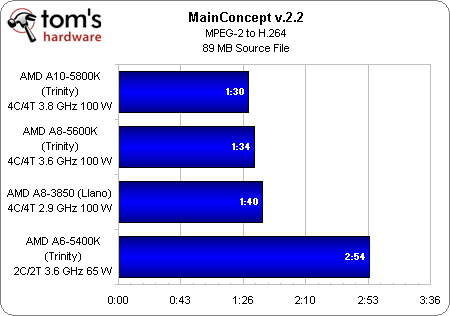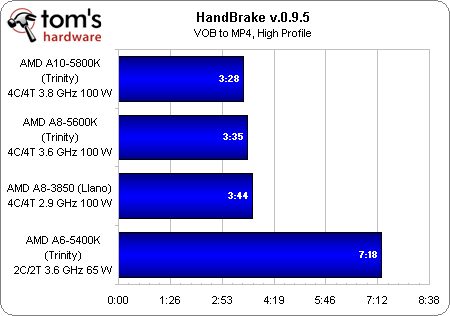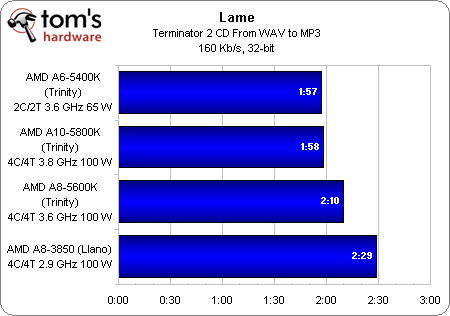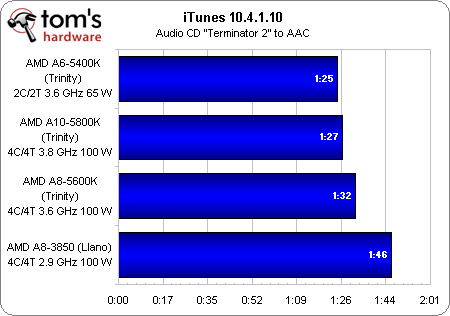AMD Trinity On The Desktop: A10, A8, And A6 Get Benchmarked!
Benchmark Results: Media Encoding
Two Trinity-based chips manage to slip past Llano. The third, A6-5400K, lags behind as a result of its dual-core architecture. Overall, though, it’s a strong showing for the Piledriver-based Trinity APUs.
We see a similar story in HandBrake, where higher frequencies help the Piledriver architecture overcome Llano’s superior IPC throughput.
An integer-based single-threaded workload like Lame should make very effective use of the resources Trinity has to offer. And indeed, we see all three upcoming APUs blow past Llano. When you look back at our tests of FX-8150 (particularly its results on this page of our Core i7-3770K story), these new Piledriver-based APUs are actually cutting through this workload faster than Bulldozer (and indeed, Phenom II X6 1100T, which accelerates up to 3.7 GHz).
The same holds true in iTunes. Finally, AMD has forward progress on its hands in the x86-based testing, whereas lightly-threaded workloads were what previously embarrassed the Bulldozer design. Although we know from comparative testing that Intel is still going to put down better numbers in a metric like this, it’s at least good to see AMD delivering on its promises of better per-clock performance from Piledriver.
Get Tom's Hardware's best news and in-depth reviews, straight to your inbox.
Current page: Benchmark Results: Media Encoding
Prev Page Benchmark Results: Productivity Next Page Benchmark Results: File Compression-
Youngmind This is so exciting! AMD is probably going to dominate the lower-end and give the poor gamers like me more bang-for-buck as their IGP get better and better :)!Reply -
dudewitbow depending on how its priced, its a really nice alternative for bare budget gaming that opens up a quad core as wellReply -
So this means that a 'Crossfired' Trinity APU would beat ANY similarly-priced Intel (CPU+discrete GPU) ???Reply
Well at least in gaming -
dudewitbow JiggerByteSo this means that a 'Crossfired' Trinity APU would beat ANY similarly-priced Intel (CPU+discrete GPU) ???Well at least in gamingReply
really the question is what gpus are able to hybrid crossfire with it. the information was never public. not all amd gpus will hybrid crossfire with it. -
Well, where are the Ivy/Sandy i5's and i3's???Reply
Once they are pitted against each other, that will be A TRUE measure of the APU Trinity's marketability -
mayankleoboy1 in the OpenCL Winzip benchmark, when openCL is enabled the workload is done only by the iGPU or the CPU as well ?Reply
i mean what is the processor usage during the benchmark ? are all CPU cores used? or only one? -
cangelini mayankleoboy1in the OpenCL Winzip benchmark, when openCL is enabled the workload is done only by the iGPU or the CPU as well ?i mean what is the processor usage during the benchmark ? are all CPU cores used? or only one?Good question--I'll take a look for you.Reply




